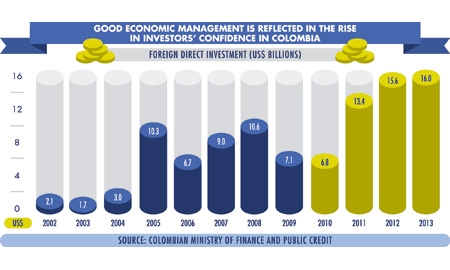Colombia is an economic success story with growth now consistently some way ahead of that of Brazil and Mexico, and inflation, at below 2% per annum, substantially lower. This is complemented by a fiscal deficit of only 2.3% and unemployment at its lowest level in 13 years. In fact, as Bernardo Noreña, President of Citibank Colombia, points out, “Colombia’s economy hasn’t seen negative growth throughout the last 15 years”.
This country with such an exceptional record of sound economic management is now bursting with self-confidence and ready to take center stage, not only in Latin America but in the wider world, and to accept all the challenges that brings.
One sign that the world is waking up to the attraction of Colombia as a major economy, trading partner and investment destination is the recent invitation for the country to join the OECD. Additionally, The Economist includes Colombia among the top 10 countries which will most drive global growth. Free trade agreements with the EU and Canada, and now, most importantly, with the United States have radically reshaped the country’s business environment, transforming its rapidly modernizing economy into a secure and attractive place to do business.
Vice-President Angelino Garzón emphasizes that the United States-Colombia Trade Promotion Agreement (CTPA), now nearly into its third year, is “an agreement of reciprocal benefits in economic and social matters.” It is a new chapter in a relationship of ever-closer ties, establishing a common framework for bilateral trade and investment together with wide-ranging provisions on labor rights, environmental protection and the protection of intellectual property rights.
The implementation of the CTPA brought an immediate boost to trade between the two countries with sharp increases in exports of U.S. agricultural products, hydrocarbon products, pharmaceuticals, aircraft, machinery, and iron and steel products.
Colombia, which had in 2013 a trade surplus with the United States of over US$3 billion, has seen 57% of its exports benefiting under the FTA, including a third of its agricultural exports, and with some almost doubling in volume, including sugar, confectionery goods, textiles, tuna and dairy products.
The CTPA really has been a two-way success story, enabling the U.S. to plug into a now regional opportunity of sustained fast growth. It greatly expands the markets open to Colombian companies and provides them with the incentive to learn and innovate in response to the requirements of American customers.
In this respect, Gabriel Vallejo, Director of the Department for Social Prosperity, remarks that “there is nothing better for a country than transferring technology, knowledge and human talent.” Bertha Cecilia Rojas, Manager of the Pacific Free Trade Zone, highlights that “our focus is on developing all kinds of agricultural products in a big effort to reach such an important market as the U.S.”
Luis Fernando Mejía, Director of Macroeconomic Policy at the Ministry of Finance, adds that the FTA is a critical step in the government’s strategy of diversifying exports, opening to “Colombian entrepreneurs a very large new market with preferential treatment.”
Besides building booming two-way trade relationships, Colombia is also becoming a magnet for foreign direct investment, which hit another record of US$16.8 billion in 2013, having increased in each of the past three years and more than doubling since 2010.
The interlinked strategies of structural economic reforms within the country and free trade agreements with some of the world’s leading economic powers, together with sound management of the national economy, mean that investing in Colombia now means investing for the world market.
| Foreign Direct investment hit a record US$16.8 billion in 2013, more than double the 2010 figure of US$6.9 billion |
Camilo Reyes Rodríguez, Executive Director of the Colombia American Chamber of Commerce (AmCham), notes that the regional Pacific Alliance with Mexico, Chile and Peru adds the further prospect of Colombia as a major component of “a bloc with huge negotiating capacity in dealing with Asian countries.”
Mr. Reyes Rodríguez also emphasizes the importance of the FTA in providing “norms and rules of legal stability for foreign investment.” In this respect, the World Bank has recognized Colombia as the leader in Latin America (and fifth in the world) in terms of legal protection for investors. The level playing field for foreign investors includes the absence of retrospective changes in legislation, commercial arbitration under international auspices, and freedom of remittance of profits.
Ricardo Triana Soto, Executive Director of the Council of American Enterprises (CEA) notes the large numbers of U.S. corporations already very much at home in Colombia, stating that “companies in the CEA account for 12-14% of Colombia’s GDP, a very important participation”.
The virtuous circle brought by FDI in the oil and extractive industries, which accounted for 81% of total foreign investment in 2013, is highlighted by Javier Díaz-Molina, Executive President of the National Association for Foreign Commerce (ANALDEX). He comments that “foreign investment has generated a dynamic and positive cycle of higher investment, higher growth and higher employment.”
AmCham’s Mr. Reyes Rodríguez now sees tremendous potential for foreign investors in support services to the oil and extractive industries, as well as in infrastructure development. The latter is believed by Juan Pablo Córdoba, President of the Colombia Securities Exchange, to have potential amounting to US$40-60 billion over the next five years.
Clearly, the welcome carpet is out for the world’s businesses to discover Colombia and write their own chapter in this continuing success story.





0 COMMENTS